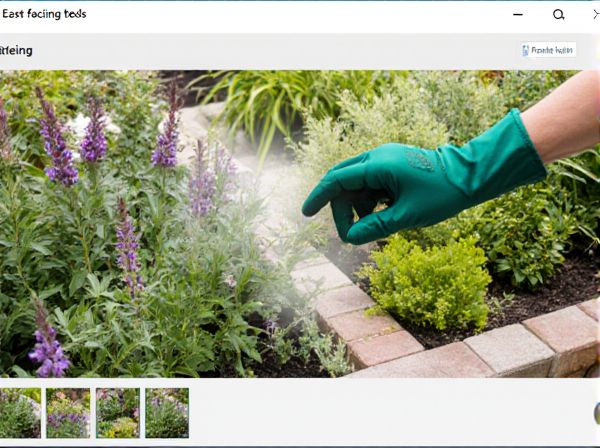
East-facing Beds vs West-facing Beds Illustration
East-facing beds benefit from gentle morning sunlight that promotes natural wakefulness and helps regulate the circadian rhythm, making it ideal for early risers. West-facing beds receive intense afternoon sunlight, which can cause overheating and disrupt sleep patterns, especially during warmer months. Choosing east-facing beds enhances comfort and supports healthier sleep cycles by harnessing soft, natural light at the start of the day.
Table of Comparison
| Aspect | East-facing Beds | West-facing Beds |
|---|---|---|
| Sunlight Exposure | Receives morning sunlight; cooler afternoons | Receives afternoon sunlight; warmer evenings |
| Temperature | Generally cooler due to morning sun | Warmer due to intense afternoon sun |
| Plant Growth | Beneficial for plants needing gentle sunlight | Suitable for sun-loving, heat-tolerant plants |
| Energy Efficiency | Reduces cooling needs in afternoon | May increase cooling load due to heat gain |
| Ideal For | Vegetables, flowers preferring less intense sun | Heat-tolerant crops and sun-demanding blooms |
| Drawbacks | Less light in afternoon may limit some plants | Risk of heat stress and water loss in plants |
Understanding Sunlight Patterns: East vs West
East-facing beds receive bright morning sunlight that promotes cooler, gradual warming, ideal for plants requiring gentle light and reduced heat stress. West-facing beds are exposed to intense afternoon sun, resulting in higher temperatures and stronger light intensity, which can benefit heat-tolerant, sun-loving plant species. Understanding these sunlight patterns helps optimize plant growth by aligning species preferences with the specific light intensity and duration each orientation provides.
Morning Sun Benefits: East-Facing Beds
East-facing beds receive abundant morning sunlight, which promotes natural circadian rhythm regulation and boosts energy levels throughout the day. Exposure to gentle morning sun helps increase vitamin D synthesis and improves mood by stimulating serotonin production. This orientation reduces overheating risk by avoiding intense afternoon sun, making it ideal for restful sleep and overall well-being.
Afternoon Sun Exposure: West-Facing Beds
West-facing beds receive intense afternoon sun exposure, which can raise soil temperatures and increase water evaporation rates. This makes them ideal for heat-tolerant and drought-resistant plants that thrive in warm conditions. Proper mulching and regular irrigation are necessary to prevent plant stress and maintain healthy growth in these beds.
Plant Selection for East-Facing Gardens
East-facing beds receive gentle morning sunlight ideal for shade-tolerant and moisture-loving plants such as ferns, hostas, and impatiens. These plants thrive in cooler, indirect light that does not scorch foliage during peak afternoon heat. Selecting crops like lettuce, spinach, and radishes in east-facing gardens also benefits from consistent hydration and reduced sun stress.
Choosing Plants for West-Facing Beds
West-facing beds receive intense afternoon sunlight, making them ideal for sun-loving plants such as tomatoes, peppers, and lavender that thrive under strong, direct rays. Drought-tolerant species like succulents and ornamental grasses also perform well in these conditions due to their resilience to heat stress. Selecting drought-resistant and heat-tolerant plants optimizes growth and reduces water demand in west-facing garden beds.
Temperature Fluctuations: East vs West
East-facing beds receive morning sunlight that gradually warms the soil, resulting in moderate temperature fluctuations ideal for seedlings and heat-sensitive plants. West-facing beds are exposed to intense afternoon sun, causing higher temperature peaks and greater fluctuations that may stress plants but benefit heat-tolerant species. Understanding these temperature dynamics helps optimize plant placement for growth efficiency and stress reduction.
Watering Needs Based on Sun Exposure
East-facing beds receive gentle morning sunlight that reduces evaporation, leading to lower watering needs compared to west-facing beds. West-facing beds endure intense afternoon sun, increasing soil moisture loss and requiring more frequent irrigation. Optimizing watering schedules based on these sun exposure patterns significantly improves water efficiency and plant health.
Impact on Flowering and Fruiting
East-facing beds receive gentle morning sunlight that promotes balanced photosynthesis, leading to improved flowering and Fruit set in plants. West-facing beds experience intense afternoon sun, which can increase heat stress and reduce flower longevity but may enhance fruit ripening in heat-tolerant species. Optimizing bed orientation based on plant type is crucial to maximizing flowering success and fruit yield.
Shade Management Strategies
East-facing beds receive morning sunlight, which is gentler and ideal for plants requiring cooler growing conditions, while west-facing beds endure intense afternoon sun that can cause heat stress and rapid soil drying. Shade management in east-facing beds prioritizes minimal intervention, often incorporating light mulching to retain moisture, whereas west-facing beds benefit from strategic use of shade cloths, taller companion plants, or pergolas to reduce sun exposure and protect sensitive crops. Effective shade management optimizes photosynthesis and prevents leaf scorch, enhancing plant health and yield in both orientations.
Maximizing Garden Productivity by Orientation
East-facing beds receive morning sunlight, promoting early photosynthesis and benefiting plants that thrive in cooler, gentler light, such as leafy greens and herbs. West-facing beds capture intense afternoon sun, ideal for heat-loving crops like tomatoes and peppers, which require longer, warmer exposure to maximize fruit production. Orienting garden beds according to plant sunlight preferences optimizes growth cycles and increases overall garden productivity.
East-facing Beds vs West-facing Beds Infographic

 gardendif.com
gardendif.com